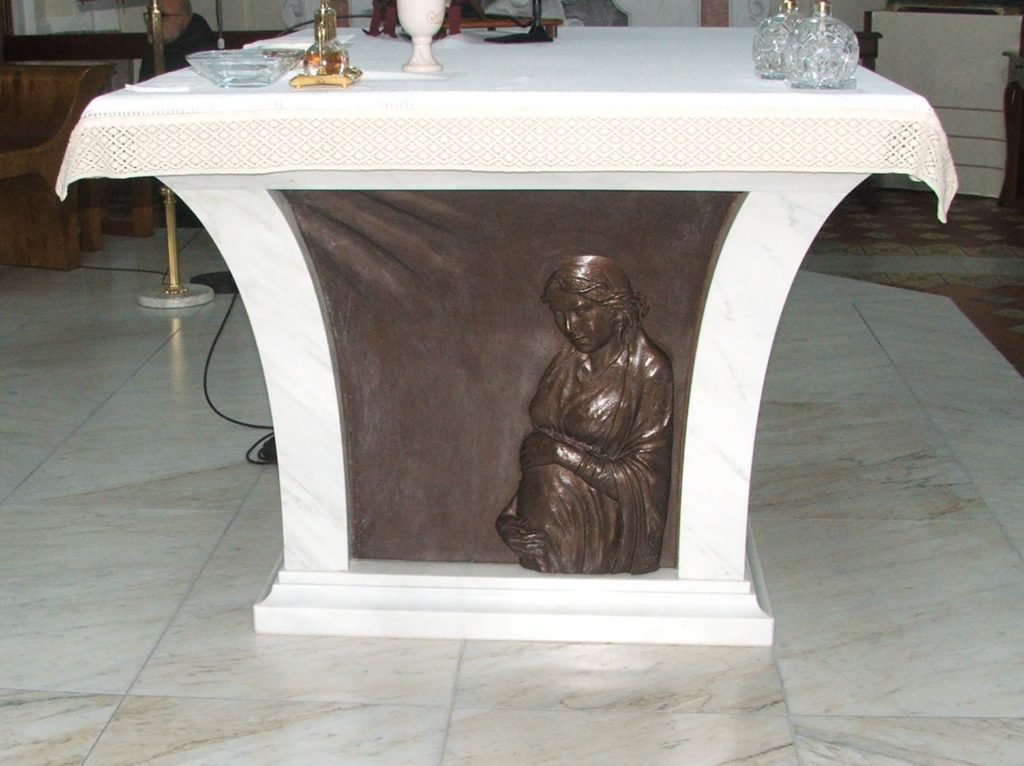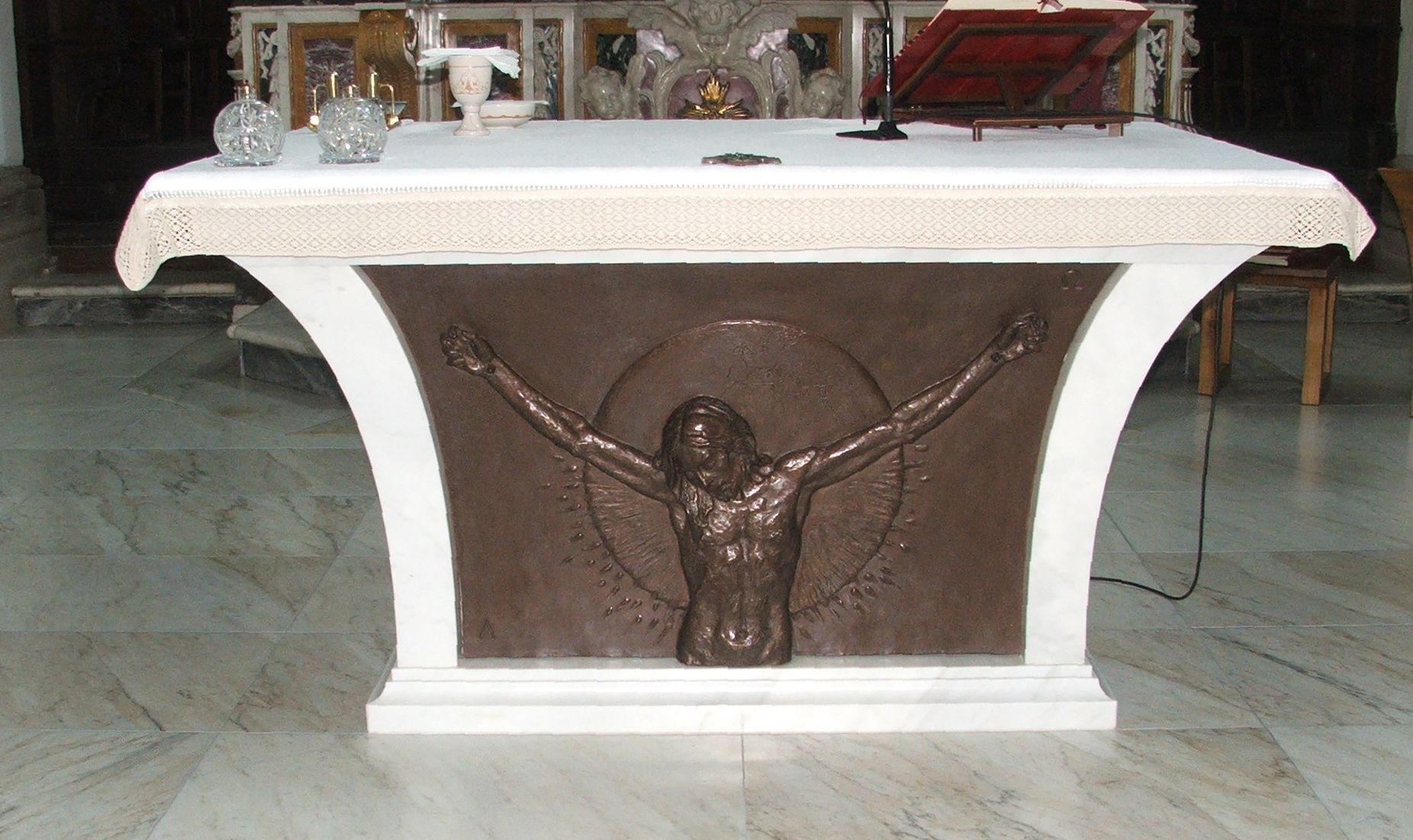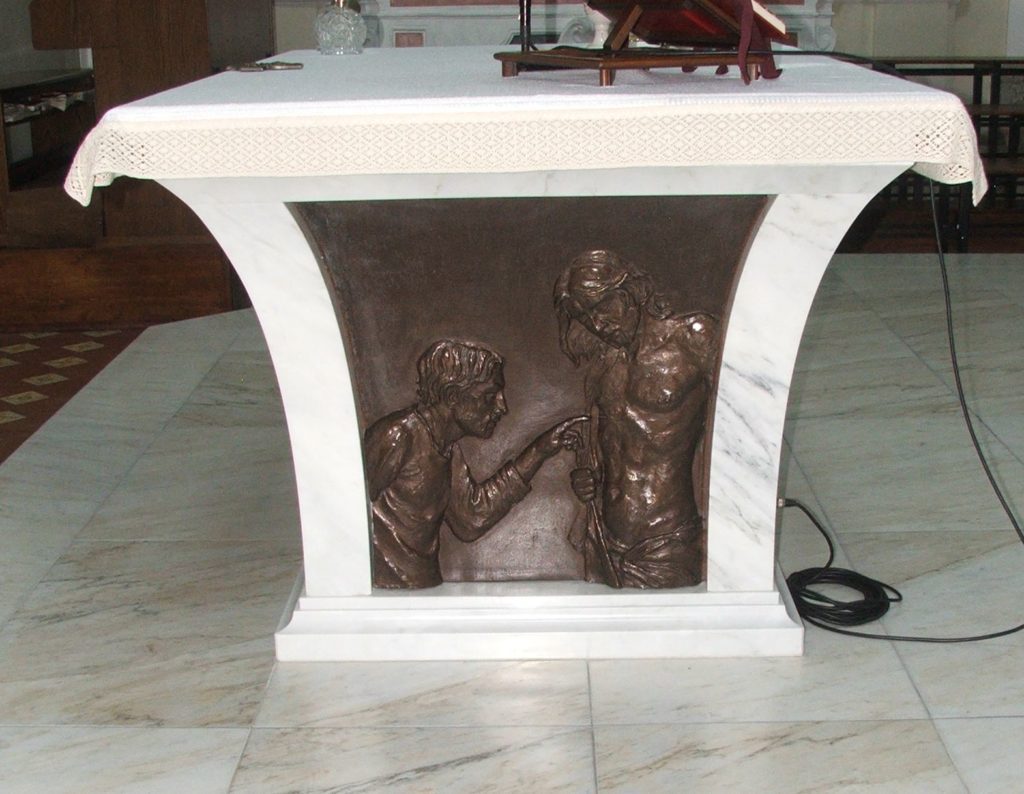Altare


Chiesa di S. Maria Maggiore
Altare
Flavio Grasso
Annunciazione, Gesù Crocifisso, Incredulità di San Tommaso apostolo
Sec. XXI (2016)
Marmo/bronzo

Church of S. Maria Maggiore
Altar
Flavio Grasso
Annunciation, Crucified Jesus, Incredulity of Saint Thomas the Apostle
21st century (2016)
Marble / Bronze
L’opera, insieme all’ambone, alla porticina del tabernacolo dell’altare e alla sedia, fa parte del complesso artistico popolarmente denominato “Incarnazione”, realizzato nel 2016 dallo scultore arianese Flavio Grasso.
L’altare, poggiante su di una base rivestita in lastre di marmo, è composto da un piano in marmo, sostenuto da un piede a forma di tronco di piramide rovesciata, con i quattro spigoli concavi. L’altare sui tre lati è decorato da pannelli in bronzo, che riproducono l’intero mistero di Cristo: incarnazione, passione, morte e risurrezione.
The work, together with the ambo, the door of the altar tabernacle and the chair, is part of the artistic complex popularly called “Incarnation”, created in 2016 by the Arianese sculptor Flavio Grasso.
The altar, resting on a base covered in marble slabs, is composed of a marble top, supported by a foot in the shape of an inverted pyramid trunk, with the four concave edges. The altar on three sides is decorated with bronze panels, which reproduce the whole mystery of Christ: incarnation, passion, death and resurrection.

Il primo pannello, laterale sinistro, rappresenta l’annuncio dell’angelo alla Vergine Maria. Protagonisti del pannello sono Maria e lo Spirito Santo che sostituisce l’Angelo dell’iconografia tradizionale. Le due figure sono rappresentate alle estremità del pannello, lasciando quindi uno spazio vuoto tra loro che, in un certo senso, è il vero protagonista dell’opera.
La Vergine è rappresentata china sul proprio ventre nell’atto di custodire e cingere il mistero che si è generato in lei. Lo Spirito Santo è rappresentato da alcuni raggi che dall’angolo in alto scendono verso Maria e verso il suo ventre.
The first panel, on the left side, represents the angel’s announcement to the Virgin Mary. Protagonists of the panel are Mary and the Holy Spirit who replaces the Angel of traditional iconography. The two figures are represented at the ends of the panel, thus leaving an empty space between them which, in a certain sense, is the true protagonist of the work.
The Virgin is represented bent over her belly in the act of guarding and encircling the mystery that has been generated in her. The Holy Spirit is represented by some rays that from the top corner descend towards Mary and towards her belly.

Il pannello frontale rappresenta la passione e la morte di Gesù Cristo, rappresentato a mezzobusto con le braccia aperte, ma senza croce che comunque viene evocata dalla posizione delle braccia. L’artista ha inteso comunicare che l’evento della Croce non è solo dolore ma anche accoglienza e che quelle braccia aperte indicano la continua accoglienza che Gesù riserva ad ogni essere umano che si rivolge a lui, soprattutto se è nell’affanno, nella solitudine e nella malattia.
I segni della passione, le stimmate, sono visibili ed indicano plasticamente il sacrificio che Gesù ha compiuto per la salvezza dell’umanità.
Alle spalle della testa del Cristo si intravede parte del globo terrestre, ad indicare che Egli ha affrontato il dolore e la morte sulla croce per la redenzione di ogni uomo, sia di chi coscientemente lo cerca, sia di chi non lo conosce.
Completano il pannello due lettere dell’alfabeto greco: l’alfa e l’omega, la prima e l’ultima lettera, che vogliono ricordare che Gesù è l’alfa e l’omega, il principio e la fine di tutto.
The signs of passion, the stigmata, are visible and indicate plastically the sacrifice that Jesus has made for the salvation of humanity.
Behind the head of the Christ we can see part of the terrestrial globe, indicating that He has faced pain and death on the cross for the redemption of every man, both of those who consciously seek him, and of those who do not know him.
The panel is completed by two letters of the Greek alphabet: the alpha and the omega, the first and the last letter, which want to remember that Jesus is the alpha and the omega, the beginning and the end of everything.

Il terzo pannello, il laterale destro, raffigura la resurrezione di Cristo, o meglio l’incontro tra Gesù risorto e l’incredulo apostolo Tommaso, quasi ad indicare che la sua risurrezione non si esaurisce con l’abbandono del sepolcro ma continua con gli eventi successivi. Non esiste risurrezione se non esiste un annuncio della stessa e Tommaso, prima non credente e poi credente, è il simbolo di questo annuncio.
Nel pannello sono chiaramente visibili Gesù e Tommaso che tende il proprio dito verso la ferita del costato. Anche qui le due figure sono ai lati del pannello, anche se sono protese verso il centro, quasi a significare che l’incontro tra l’uomo e Dio è fatto di un continuo gioco di proposta e accoglienza, di offerta e dono.
The third panel, the right side, depicts the resurrection of Christ, or rather the encounter between the risen Jesus and the unbelieving apostle Thomas, as if to indicate that his resurrection does not end with the abandonment of the sepulcher but continues with the following events. There is no resurrection if there is no announcement of the same and Thomas, first non-believer and then believer, is the symbol of this announcement.
In the panel are clearly visible Jesus and Thomas who stretches his finger towards the wound of the side. Here too the two figures are on the sides of the panel, even if they are stretched out towards the center, as if to signify that the encounter between man and God is made of a continuous game of proposal and welcome, of offer and gift.
